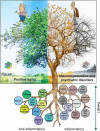Healthy lifestyles and wellbeing reduce neuroinflammation and prevent neurodegenerative and psychiatric disorders
- PMID: 36875655
- PMCID: PMC9975355
- DOI: 10.3389/fnins.2023.1092537
Healthy lifestyles and wellbeing reduce neuroinflammation and prevent neurodegenerative and psychiatric disorders
Abstract
Since the mid-20th century, Western societies have considered productivity and economic outcomes are more important than focusing on people's health and wellbeing. This focus has created lifestyles with high stress levels, associated with overconsumption of unhealthy foods and little exercise, which negatively affect people's lives, and subsequently lead to the development of pathologies, including neurodegenerative and psychiatric disorders. Prioritizing a healthy lifestyle to maintain wellbeing may slow the onset or reduce the severity of pathologies. It is a win-win for everyone; for societies and for individuals. A balanced lifestyle is increasingly being adopted globally, with many doctors encouraging meditation and prescribing non-pharmaceutical interventions to treat depression. In psychiatric and neurodegenerative disorders, the inflammatory response system of the brain (neuroinflammation) is activated. Many risks factors are now known to be linked to neuroinflammation such as stress, pollution, and a high saturated and trans fat diet. On the other hand, many studies have linked healthy habits and anti-inflammatory products with lower levels of neuroinflammation and a reduced risk of neurodegenerative and psychiatric disorders. Sharing risk and protective factors is critical so that individuals can make informed choices that promote positive aging throughout their lifespan. Most strategies to manage neurodegenerative diseases are palliative because neurodegeneration has been progressing silently for decades before symptoms appear. Here, we focus on preventing neurodegenerative diseases by adopting an integrated "healthy" lifestyle approach. This review summarizes the role of neuroinflammation on risk and protective factors of neurodegenerative and psychiatric disorders.
Keywords: healthy lifestyle; neurodegeneration; neuroinflammation; psychiatric; reduce risk; wellbeing.
Copyright © 2023 Kip and Parr-Brownlie.
Conflict of interest statement
The authors declare that the research was conducted in the absence of any commercial or financial relationships that could be construed as a potential conflict of interest.
Figures




Similar articles
-
Reducing neuroinflammation via therapeutic compounds and lifestyle to prevent or delay progression of Parkinson's disease.Ageing Res Rev. 2022 Jun;78:101618. doi: 10.1016/j.arr.2022.101618. Epub 2022 Apr 5. Ageing Res Rev. 2022. PMID: 35395416 Review.
-
Dietary habits, lifestyle factors and neurodegenerative diseases.Neural Regen Res. 2020 Mar;15(3):394-400. doi: 10.4103/1673-5374.266045. Neural Regen Res. 2020. PMID: 31571647 Free PMC article. Review.
-
The role of adolescent lifestyle habits in biological aging: A prospective twin study.Elife. 2022 Nov 8;11:e80729. doi: 10.7554/eLife.80729. Elife. 2022. PMID: 36345722 Free PMC article.
-
The effectiveness of web-based programs on the reduction of childhood obesity in school-aged children: A systematic review.JBI Libr Syst Rev. 2012;10(42 Suppl):1-14. doi: 10.11124/jbisrir-2012-248. JBI Libr Syst Rev. 2012. PMID: 27820152
-
Mitochondrial metabolism: a common link between neuroinflammation and neurodegeneration.Behav Pharmacol. 2019 Dec;30(8):642-652. doi: 10.1097/FBP.0000000000000505. Behav Pharmacol. 2019. PMID: 31625975 Review.
Cited by
-
Original article: adolescent dietary patterns derived using principal component analysis and neuropsychological functions: a cross-sectional analysis of Walnuts Smart Snack cohort.Eur Child Adolesc Psychiatry. 2025 May;34(5):1569-1578. doi: 10.1007/s00787-024-02577-6. Epub 2024 Sep 18. Eur Child Adolesc Psychiatry. 2025. PMID: 39292245 Free PMC article.
-
Associations of cardiovascular risk factors and lifestyle behaviors with neurodegenerative disease: a Mendelian randomization study.Transl Psychiatry. 2023 Jul 24;13(1):267. doi: 10.1038/s41398-023-02553-9. Transl Psychiatry. 2023. PMID: 37488110 Free PMC article.
-
Sexual Dimorphism in Levodopa-Induced Dyskinesia Following Parkinson's Disease: Uncharted Territory.Eur J Neurosci. 2025 May;61(9):e70144. doi: 10.1111/ejn.70144. Eur J Neurosci. 2025. PMID: 40360439 Free PMC article. Review.
-
Conservative Management of Acute Sports-Related Concussions: A Narrative Review.Healthcare (Basel). 2024 Jan 23;12(3):289. doi: 10.3390/healthcare12030289. Healthcare (Basel). 2024. PMID: 38338173 Free PMC article. Review.
-
Mechanisms of Post-Stroke Fatigue: A Follow-Up From the Third Stroke Recovery and Rehabilitation Roundtable.Neurorehabil Neural Repair. 2024 Jan;38(1):52-61. doi: 10.1177/15459683231219266. Epub 2023 Dec 29. Neurorehabil Neural Repair. 2024. PMID: 38156702 Free PMC article. Review.
References
-
- Albert M. A., Glynn R. J., Ridker P. M. (2003). Alcohol consumption and plasma concentration of C-reactive protein. Circulation 107 443–447. 10.1161/01.CIR.0000045669.16499.EC - DOI - PubMed
Publication types
LinkOut - more resources
Full Text Sources
Miscellaneous

